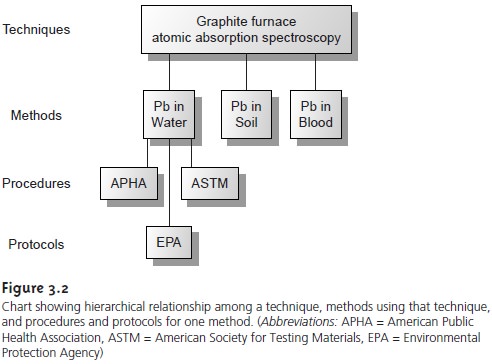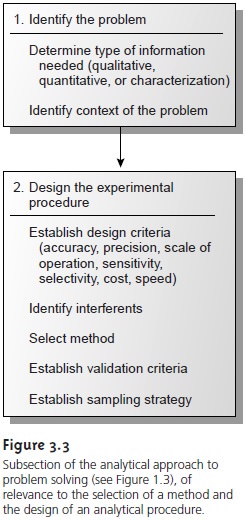Chapter: Modern Analytical Chemistry: The Language of Analytical Chemistry
Language of Analytical Chemistry: Techniques, Methods, Procedures, and Protocols
Techniques,
Methods, Procedures, and Protocols
Suppose you are asked to develop a way to determine the concentration of lead in drinking water. How would
you approach this problem? To answer this question it helps
to distinguish among
four levels of analytical methodology: techniques, meth-
ods, procedures, and protocols.
A technique
is any chemical or physical principle that can be used to study an analyte. Many techniques have
been used to determine lead
levels.2 For example, in
graphite furnace atomic
absorption spectroscopy lead
is atomized, and
the ability of the
free atoms to absorb light
is measured; thus,
both a chemical principle (atom- ization) and a physical
principle (absorption of light) are used in this technique.
A method is the
application of a technique for
the determination of a specific analyte in a specific matrix. As shown
in Figure 3.2,
the graphite furnace
atomic ab- sorption spectroscopic method for determining lead levels in water is different from that
for the determination of lead in soil or blood. Choosing
a method for deter-
mining lead in water depends
on how the information is to be used and the estab- lished design criteria (Figure
3.3). For some analytical problems the best method might use graphite furnace
atomic absorption spectroscopy, whereas other prob- lems might be more easily solved by using another technique, such as anodic strip-
ping voltammetry or potentiometry with a lead ion-selective electrode.


A procedure is a set of written directions detailing how to apply a method to a particular sample, including information on proper sampling, handling of interfer- ents, and validating results. A method does not necessarily lead to a single proce- dure, as different analysts or agencies will adapt the method to their specific needs. As shown in Figure 3.2, the American Public Health Agency and the American Soci- ety for Testing Materials publish separate procedures for the determination of lead levels in water.
Finally, a protocol is
a set of stringent written
guidelines detailing the proce-
dure that must be followed if the agency
specifying the protocol is to accept
the re- sults of the analysis.
Protocols are commonly
encountered when analytical chem- istry is used
to support or define public
policy. For purposes of determining lead levels in water under
the Safe Drinking
Water Act, labs follow a protocol specified by the Environmental Protection Agency.
There is an obvious order
to these four
facets of analytical methodology. Ide-
ally, a protocol uses a previously validated procedure. Before developing and vali- dating a procedure, a method of analysis must be selected. This requires, in turn, an initial screening of available
techniques to determine
those that have the potential for monitoring the analyte.
We begin by considering a useful way to classify
analyti- cal techniques.
Related Topics